Lamb Modified With Jellyfish Gene Goes on the Market, Prompts Investigation
The lamb was being used for a study on heart disease.

— -- A lamb that was genetically modified with genes from a jellyfish was sold from a lab, in violation of French law, according to French officials who have launched an investigation into the sale.
The lamb had been part of a study researching if grafted cells could stop a myocardial infarction, or a heart attack, with sheep standing in for human subjects, authorities said.
The lamb was born to a genetically modified ewe that had a gene derived from jellyfish, resulting in a "green fluorescent protein" that makes certain cells florescent and is used to help researchers see how an affected area is working.
The animal was reportedly sold in October 2014, according to France's National Institute for Agricultural Research (INRA).
The lamb was taken to a slaughterhouse in 2014 and then sold on, which is against the law in France. France bars any "sale of any product consisting of genetically modified organisms or containing such organisms."
Despite the genetic tinkering, the lamb was determined under French regulations to be a genetically modified animal that had "null or negligible" risk to the public.
While the lamb’s mother had been modified so that the lambs would have florescent protein cells derived from jellyfish, the proteins never worked in the lamb, according to INRA.
This month, INRA turned over the investigation to a public prosecutor due to the gravity of the charges.
Gregory Jaffe, biotechnology project director at the Center for Science in the Public Interest, a health and nutrition advocacy, said it’s unlikely a single lamb would significantly impact the public health but the incident could be troubling for other research institutions.
“I don’t think it should in any way alter research in this area,” Jaffe told ABC News. “But it could be a cautionary tale for institution that are doing research ... to make sure they have proper checks and balances to ensure that those animals are destroyed properly.”



